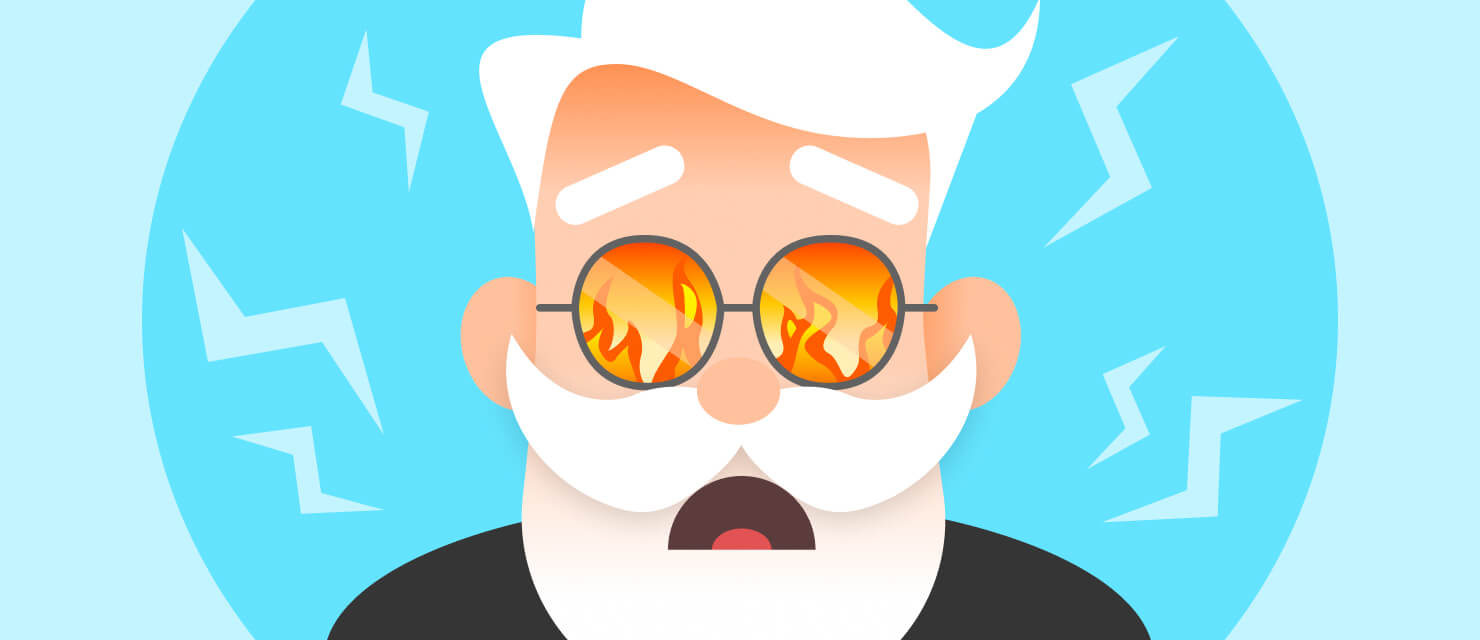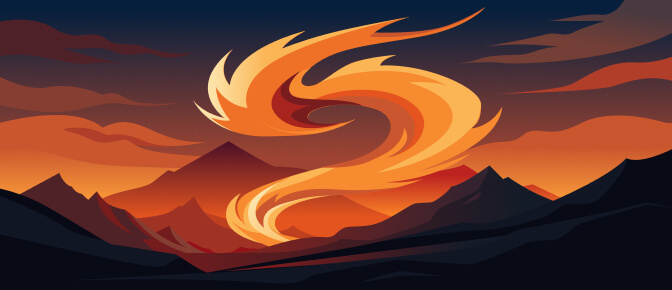Fires can be called companions of progress. When people left the stone caves and began to build wooden dwellings, they started fighting fires. As a rule, great fires came along with wars, but sometimes there were also natural causes. In this article, we’ll take a look at the 10 fires that changed history, including the deadliest fires from ancient times until today.
Fire in Rome, 64 AD
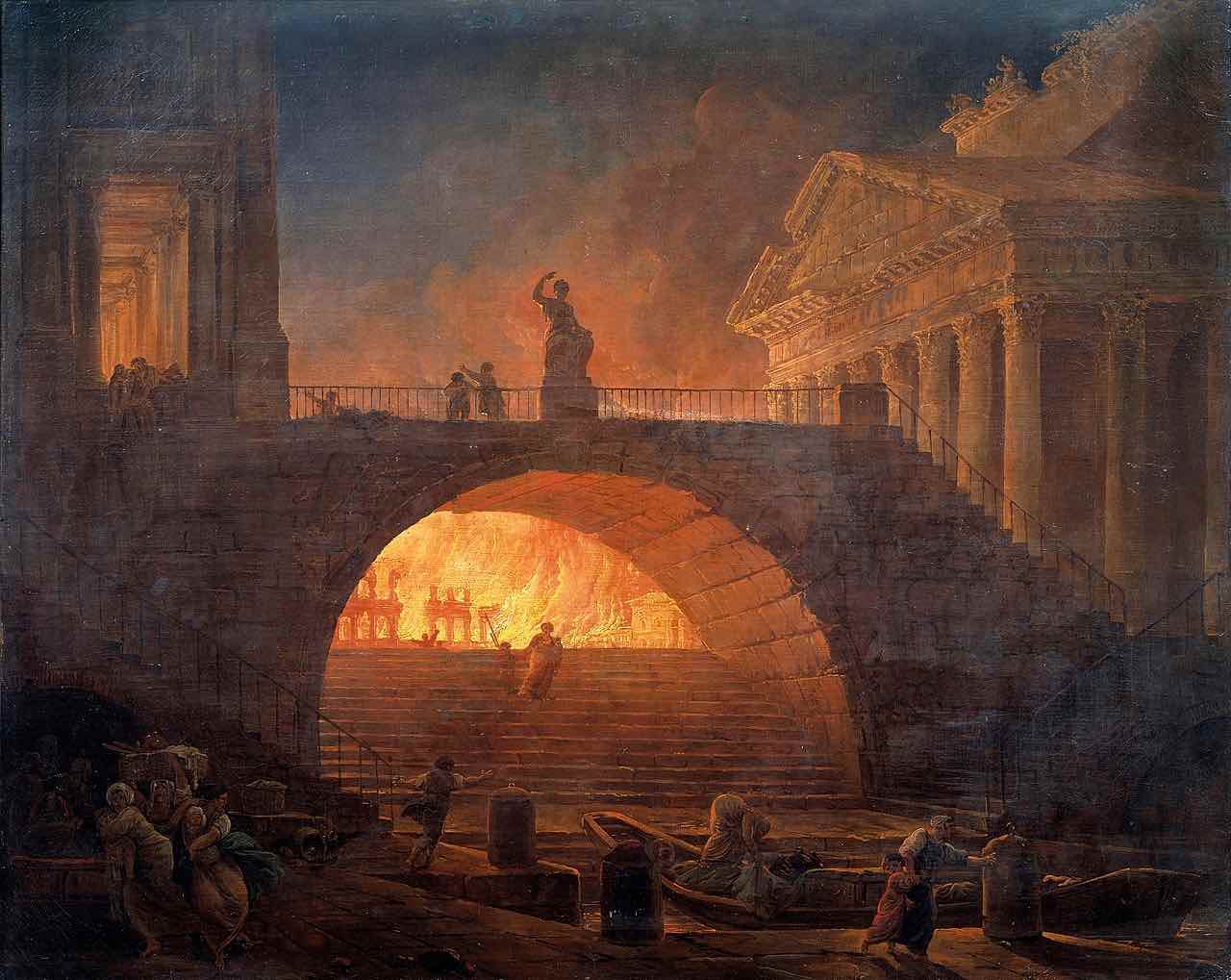 Image source: Wikipedia
Image source: Wikipedia
In 64 AD, the emperor of Rome was Nero, a cruel ruler who hated and tortured Christians. On July 19, 64, a fire broke out in Rome. Some researchers consider this an accident. The emperor himself blamed the Christians. On the contrary, the citizens whispered that the extravagant tyrant ruler set Rome on fire. That night, Nero watched from the balcony with a joyful face at how Rome was burning, and many saw it.
The primary sources on the history of the Roman fire have not been preserved, so its cause is still not clear. The scale of the disaster was catastrophic. The fire was blazing for 6 days. The high wind carried the flame throughout the city and completely destroyed it. After the disaster, all the blame fell on the unfortunate Christians, who were publicly punished.
The Great Fire of London, 1666
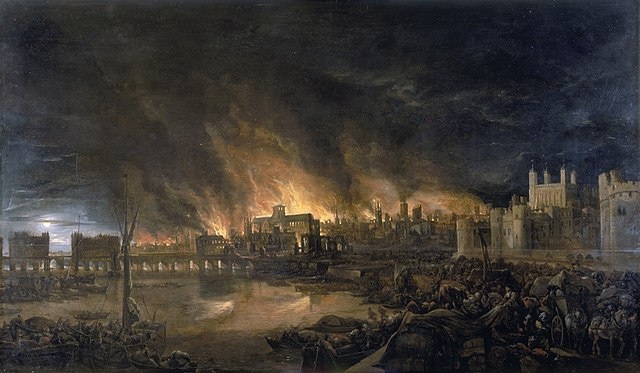 Image source: [Wikipedia](https://en.wikipedia.org/wiki/Great_Fire_of_London{:rel=”nofollow”}{:target=”_blank”}
Image source: [Wikipedia](https://en.wikipedia.org/wiki/Great_Fire_of_London{:rel=”nofollow”}{:target=”_blank”}
The Great Fire of London took place in 1666. This disaster is considered one of the largest in the city’s recorded history. With only 6 deadly victims recorded, the blaze lasted 4 days and burned down 13,200 houses.
The fire occurred on the night of September 2, 1666, at the home of the baker Thomas Farriner in Pudding Lane. It probably started as a spark from an unextinguished hearth. The blaze was raging until 6 September, and the losses were enormous. According to experts, 70,000 London residents lost their homes. The fire burned many administrative buildings and churches, including St. Paul’s Cathedral. At first, the authorities attempted to blame the Catholics for the arson. But in 1667, the Royal Council ruled that the fire was caused by “the hand of God, a strong wind, and a very dry season.”
The Great Fire of New York, 1776
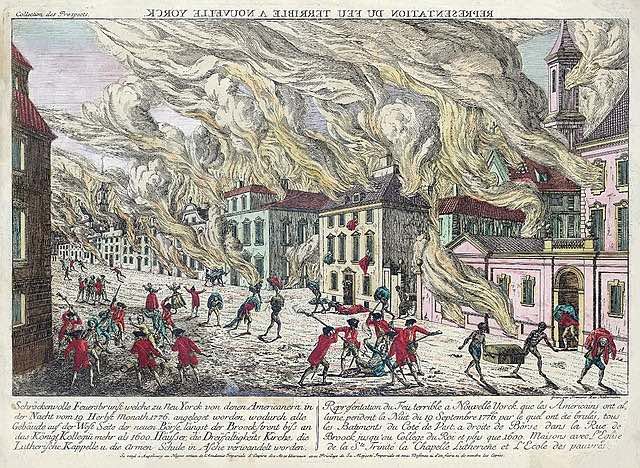 Image source: Wikipedia
Image source: Wikipedia
In 1776, the United States was not yet independent. America was a British colony, and the Americans fought a war for independence against the European colonizers. By the summer of 1776, the British were already in New York. Suddenly, one of the revolutionary officers came up with the idea to burn the city together with the colonialists instead of fighting them.
Most of the American command rejected this idea, but a week later, on September 20, the city still caught fire. The fire started in one of the cafes, and the wind quickly threw the blaze from one building to another. As a result, almost 500 houses burned down, and many invaders died. The officers of the revolutionary army had already left the city by that time.
The Great Chicago Fire, 1871
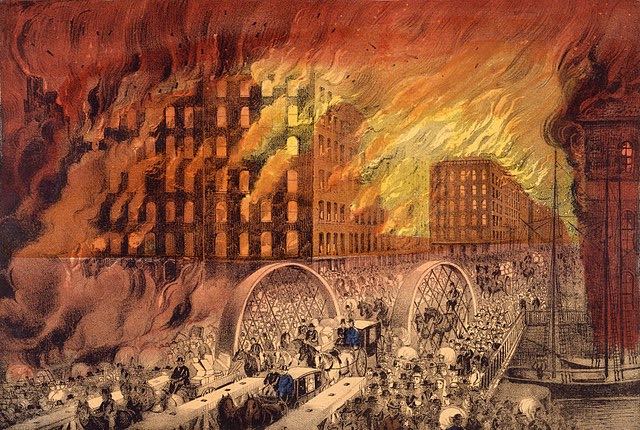 Image source: Wikipedia
Image source: Wikipedia
A huge fire in Chicago brought massive destruction to the city, having burned down 17,000 buildings. The blaze lasted from October 8 to October 10. It is worth noting that the fire spread rather slowly, so the number of deadly victims was relatively small: about 300 people. But the further fierce winter significantly hit the fire victims, who were left without a roof over their heads.
The Great Fire of Chicago broke out at 9 pm, probably in the barn of the O’Leary family. When the blaze was reported, neighbors rushed to save O’Leary’s home from the blaze. Strong winds from the southwest caused neighboring houses to ignite, and the blaze headed toward downtown.
Because of another fire on the previous day, the fire brigade was exhausted, so warning signals and information were not taken seriously enough. Some sources report that the river also caught fire from wooden boats, driftwood, and greasy debris. The blaze also spread along the Polk Street Bridge (which was destroyed in the process and has not been rebuilt to date) and further into the southern parts of Chicago.
Many buildings destroyed had unique architectural features, for example, the publishing house of the Chicago Tribune newspaper on Dearborn and Madison Streets. Among the buildings that survived the fire or were rebuilt are the water tower and the Unity Church.
- 75 miles of roads,
- 120 miles of sidewalks,
- 2,000 lamp posts,
- 17,000 buildings,
- and $200 million in property.
Peshtigo Fire, 1871
1871 became rich in deadly fires. Just a few hundred miles away from Chicago, a wildfire burned down the small town of Peshtigo. This event was recorded in history as the largest forest fire. The wildfire burned 17 cities to the ground, and its flames swallowed up an area of about 2,000 square miles. It was impossible to calculate the number of victims due to the remoteness of the area. Approximate data speak of 2,500 victims. Almost all inhabitants of Peshtigo died. Fire tornadoes rushed through the cities, igniting everything in their path. There was no one to help the victims, as all the firefighters were sent to Chicago.
The Peshtigo, Port Huron, and Great Chicago Fire are also known under the common name of the Great Michigan Fire. It was one of the worst forest fires at that time. Additionally, in 1881, another blaze in the Thumb region nearby followed almost the same path as the Great Michigan Fire.
Boston Fire, 1872
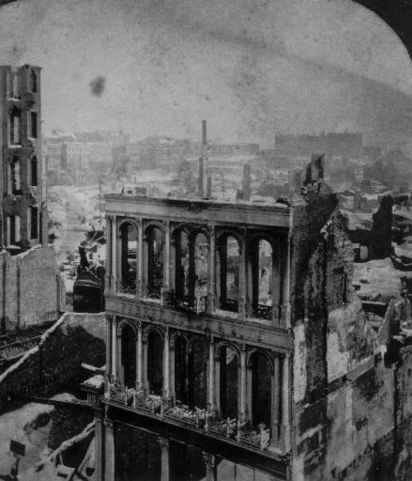 Image source: Wikipedia
Image source: Wikipedia
The Great Boston Fire was the largest urban fire and is still considered one of the costliest economic losses in U.S. history. The blaze engulfed 65 acres and 776 buildings in Boston’s downtown, causing $73.5 million in damage.
On Saturday, November 9, 1872, just after 7 pm, the fire started in the basement of a five-floor warehouse on the corner of Kingston and Summer Streets. There was no one in the building when the blaze started, but witnesses claim that the first signs of fire appeared in the windows of the basement.
The exact cause of the blaze will never be determined. However, the general consensus is that a spark from a coal boiler powering an elevator inside the building may have ignited combustible materials. Whatever the cause, the flames quickly began to spread from building to building, from roof to roof, covering entire blocks of buildings.
After a 20-hour rage, the blaze was put down near Boston’s historic landmarks: Old South Meeting House, Faneuil Hall, and Old Government House. Hundreds of people lost their homes, thousands became unemployed, and thirty people died.
The Great Boston Fire left a solid legacy in American history, thanks to the efforts of Boston Fire Chief John Damrell. Immediately after the disaster, Damrell established the National Association of Fire Chiefs (now the International Association of Fire Chiefs (IAFC)), a key organization in establishing universal building codes for fire safety. Damrell also became a building inspector for Boston to verify that building requirements were met.
Texas Fire, 1947
The cause of the Texas fire of 1947 was a cigarette thrown on board a ship that carried 2,300 tons of ammonium nitrate. The shock wave from the explosion was so strong that it was recorded by seismographs thousands of kilometers from the epicenter.
In a chain reaction, neighboring ships on the pier began to ignite, and then the blaze quickly spread to oil refineries and chemical plants. However, the tragedy did not end there. The next day, another ship with saltpeter exploded. As a result, thousands of buildings were wiped off the face of the earth, and about 600 people died, among them the entire voluntary fire brigade. It took hundreds of millions of dollars to later restore the burned Texas.
Fire in Yellowstone National Park, 1998
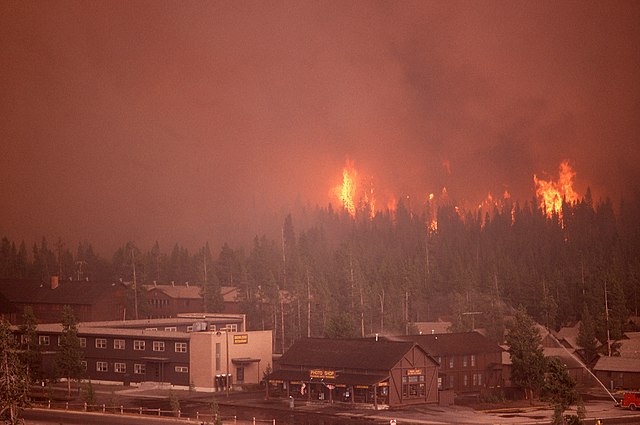 Image source: Wikipedia
Image source: Wikipedia
Between the end of July and August 1988, eight devastating fires broke out in Yellowstone Park, all of which originated from small fires. It was impossible to tame the blaze because of drought and high winds. Wind gusts reached 50 miles per hour. Because of this, the fire advanced 12 miles per day.
Authorities threw all forces into the fight with the blaze. Almost 10,000 civilian and military firefighters took part in extinguishing the fire. About 5,000,000 liters of flame retardants and 40,000,000 liters of water were dropped from helicopters and tanker aircraft. But the blaze did not give up: it continued to advance, having almost swallowed several settlements. For many days a thick curtain of smoke was hanging in the air. In the late summer, the park resembled a battlefield. In mid-September, thanks to cool weather, autumn thunderstorms, and the first snowfall, the disaster finally subsided.
Cedar Fire, 2003
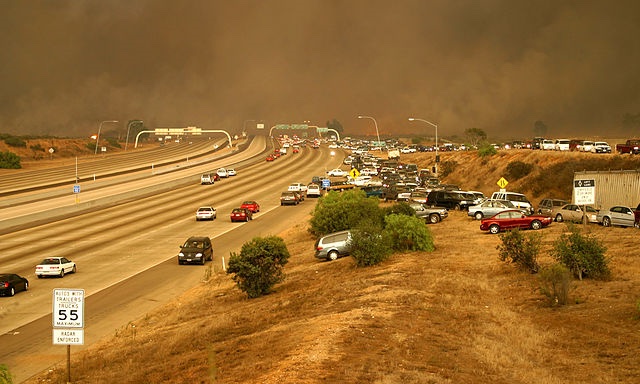 Image source: Wikipedia
Image source: Wikipedia
This forest fire took place in San Diego, California, between October and December 2003. It is considered to be one of the worst wildfires in California history, although the blaze occurred outside of the state’s worst fire season. When the fire began on October 25, 2003, it joined another 11 wildfires that were already burning in Southern California.
The Cedar Fire spread rapidly thanks to the Santa Ana wind and drought conditions, having destroyed 2,820 buildings and killed 15 people. Two firefighters got injured and one died. Economic damage from the disaster amounted to $1.3 billion.
Cedar is the largest wildfire in San Diego County according to the area of burned land and the number of buildings destroyed.
| Fire name | Burned land, acres | Destroyed buildings |
|---|---|---|
| Cedar | 273,246 | 2,820 |
| Paradise | 56,700 | 415 |
| Otay | 46,291 | 6 |
Table data source: U.S. Department of Agriculture
August Complex Fire, 2020
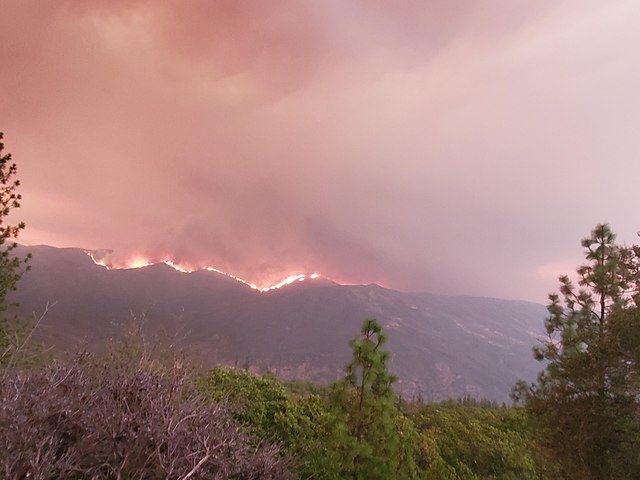 Image source: Wikipedia
Image source: Wikipedia
This complex fire united 38 separate fires in Northern California, which started as a result of a lightning strike in the middle of August 2020. It became both the largest fire complex and the single largest wildfire in California history. The biggest fires included in the complex were the Doe, Glade, Hull, Tatham, and Elkhorn Fire. These forest fires burned over one million acres of land, mostly in the Mendocino National Forest. As with many California wildfires, the structure of the land complicated the fire containment efforts. It took nearly 3 months to finally extinguish this destructive wildfire.
Conclusion
Wildfires and other blazes are extremely dangerous. The key reason is that a small fire can quickly turn into a large-scale natural disaster, leaving behind burned land and provoking a climate crisis. Fire warnings should never be ignored, so we strongly urge you to take them seriously. Activate severe weather alerts in RainViewer’s Notification Center and never miss a fire warning on your smartphone. Stay safe!
